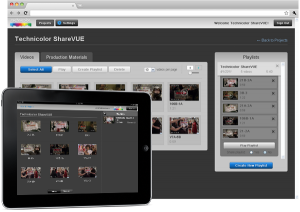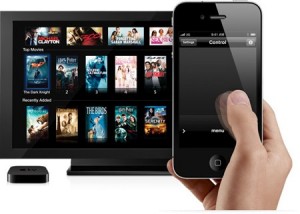
By
Rob ScottApril 13, 2011
Rob Woodbridge of UNTETHER.tv hosts a three-person online video panel for Episode 12 of his site’s program, The Week in Mobile. The informal 56-minute discussion provides an interesting take on how mobility is shaping content consumption — with a focus on “The iPad Effect” and its rapidly developing impact on the PC industry.
The panel cites a recent Fast Company article in which analysts anticipate 35 of the 45 million tablets expected to sell in the upcoming year will be iPads and that the only way for others such as Dell, Motorola, Samsung and RIM to compete with Apple is to dramatically undercut the price — begging the question, “Is the tablet PC industry really an industry yet at all?”
Additionally, as PC makers are being adversely impacted by the growing success of the iPad — not only with tablet sales, but in regards to laptops and desktops sales — another result may be the surprising “stealthy” success of MacBook Airs (for which the panel credits the proliferation of apps). According to Fast Company, the Air grabbed 15 percent of of the total notebook sales for the last quarter of 2010.
The discussion also addresses mobile privacy abuse in a new era of apps and Amazon’s concern regarding the consumer power enabled by NFC wireless technologies.

By
Rob ScottApril 12, 2011
Sony unveiled its new F65 CineAlta digital motion picture camera at an NAB press conference in Las Vegas this week. The F65 camera features a 20.4 megapixel, Super 35mm CMOS sensor, a significant jump from the F35’s 12.4 megapixel 1080p CCD. Is this another step away from film as a motion picture medium?

Pictured on the left is Curtis Clark (ASC) who directed a 4K short with the new camera, that is being shown at NAB.
According to Engadget: “…this sensor is fast — not only can it capture up to 72fps on 4K, but it can also crank up to a smooth 120fps on 2K. As for those seeking to squeeze out every bit of detail from their clips, don’t worry: the F65’s got you covered with a 16-bit RAW output (19Gbps) at 4K resolution, or it can be compressed to 5Gbps for the convenience of recording onto the new SR-R4 portable 4K recorder. Looks like Sony’s finally found a candidate that’ll put a lid on film stock, but then again, at the end of the day it’ll depend on the price tag when it comes out in Q3 this year.”
Sony also announced 2 new professional 3D cameras at NAB (and for consumers, the company announced the 3D Handycam and 3D Bloggie cameras at January’s CES).
Read the Sony Blog report on the NAB unveiling: “Sony Kicks off NAB with the announcement of a new 4K professional camera” (4/11/11)
Related Engadget post: “Sony shoots out CineAlta F65 4K camera and PMW-TD300 3D camcorder at NAB” (4/11/11)
The Photography Bay write-up includes video coverage of the NAB press conference and behind-the-scenes footage with Curtis Clark directing a 4K short with the new camera.

By
Rob ScottApril 11, 2011
GoPro is gaining in consumer popularity thanks to its collection of Hero Camera mounts that allow users to attach inexpensive cameras to everything from ski helmets to the tips of surfboards for action footage. Already popular with skiers, snowboarders, surfers, bikers and other outdoor enthusiasts and extreme athletes, the GoPro line is starting to become more common with professional cameramen as well. Nature photographers, in particular, are using GoPro products to shoot footage of hard-to-reach places, such as inside a cobra’s den or a shark’s mouth.
 The small, six-ounce, 1080p camera comes with a water-tight housing and starts at $260.
The small, six-ounce, 1080p camera comes with a water-tight housing and starts at $260.
GoPro’s parent company, Woodman Labs Inc., is receiving funding from outside investors, including Steamboat Ventures, a venture capital fund backed by Disney (Steamboat Ventures was also an investor in Pure Digital, maker of the popular Flip pocket camcorder). Steamboat plans to help GoPro expand further into the professional market.
Gizmodo offers a positive review of the 3D Hero System — a $99 3D kit (cameras not included) that GoPro bills as “the world’s smallest 1080p 3D camera.” The system combines two HD cameras in a waterproof housing that enables users to shoot synchronized photos and video (2D and 3D) that can then be edited in 3D with the free CineForm Studio software.
Most helmet and similar cameras have gone to wide angle lenses to ensure footage and minimize shake. The result was effective, but made things look smaller when viewed. Gizmodo notes that “adding 3D gives depth to the trees and objects rushing past you,” providing for a more immersive viewing experience.
You can check out the GoPro video demo to see how the 3D Hero System works.
Related Wall Street Journal story: “Camcorder Popular With Surfers Looks to Ride Professional Market” (4/6/11)

By
Rob ScottApril 10, 2011
Technicolor announced its next-generation secure, cloud-based dailies solution for film and television studio clients. According to the press release, ShareVUE enables remote viewing, collaboration and sharing of dailies content on HTML5-supported web browsers, iOS and Android devices. Technicolor explains it is working with the Squeeze Solution Pack encoding technology from Sorenson Media to implement cloud-based scalability.
 ShareVUE features include:
ShareVUE features include:
— A central hub to remotely view production materials while sharing time-stamped comments and playlists.
— A single encode that is transcoded and optimized “behind-the-scenes” to maximize visual quality for each supported device.
— Streaming-only model ensures media security, and includes content protection protocols combined with link encryption protocols, content scrambling and dynamic watermarking techniques.
Related Variety article: “Technicolor, Canon pact for cinematographers” (4/5/11)
By
Rob ScottApril 10, 2011
Michael White took over the reigns of DirecTV the beginning of this year as the new president and CEO. During a recent three-day retreat with senior executives, White outlined the company’s strengths and weaknesses, and shared his vision for future growth, especially in regards to possible expansion in Latin America and reaching out to customers who use mobile devices. Investor’s Business Daily reports that DirecTV “is the world’s largest pay TV services provider with more than 28 million subscribers in the U.S. and Latin America.”
White emphasized that DirecTV is in excellent shape, but that an effective strategic plan would help steer the company into the future. His immediate focus is on recent deals with AT&T and Verizon that allow DirecTV to sell broadband services over fiber networks, the next phase of DirecTV’s recently launched free iPad application, and expanding the number of customers in Latin America (currently at 9 million).
“I was convinced that Latin America was still the best growth opportunity, and we should really expand more aggressively in Latin America,” White said. “In the U.S., we had a terrific core business, but we needed to address the ‘anytime, anywhere’ TV evolution and we needed some other revenue growth opportunities to help drive the top line while we were wrestling with higher programming costs.”
DirecTV’s first iPad app has some interesting features, yet is somewhat limited in its functionality for those truly on-the-go. It can serve as a remote control to change channels, browse channels without interrupting what’s on TV at the time, record to a DVR, and create a home screen with access to favorite channels. Users can use the app outside the home to schedule programs, but cannot currently use it to view programming. This may be the biggest obstacle for mobile device enthusiasts. White explains that phase two will enable users to import DVR content that has already been recorded to the iPad for remote viewing.
White says that DirecTV’s strategy to increase market share in Latin America involves a segmented approach by focusing on the quality of HD and DVR offerings — in addition to offering lower-priced packages, specifically targeting the middle-class who have so far been reluctant to take the plunge with paid services.

By
Rob ScottApril 9, 2011
In his first public appearance since joining Hewlett-Packard in November, CEO Leo Apotheker delivered a speech in San Francisco that outlined the company’s new online strategy that he explained will target both consumers and businesses. Apotheker emphasized cloud computing and an online app store as part of his vision to bring HP to the forefront as “the platform for the cloud and connectivity.” He suggested that the app store would include programs from HP as well as from other companies.
 Apotheker dismissed speculation that HP would be acquiring software maker SAP AG or any other provider of transactional business programs. The Wall Street Journal reports that his goal is to address the “increasing amount of unstructured data — information that isn’t easily categorized”; HP will “focus on products and services that will help businesses better make sense of them.”
Apotheker dismissed speculation that HP would be acquiring software maker SAP AG or any other provider of transactional business programs. The Wall Street Journal reports that his goal is to address the “increasing amount of unstructured data — information that isn’t easily categorized”; HP will “focus on products and services that will help businesses better make sense of them.”
Apotheker explained that the company’s webOS operating system (newly acquired along with Palm last year) is designed for smartphones and tablets, but will also ship on HP PCs, providing the company with a greater scale. HP plans to produce laptops and desktops with webOS working alongside Windows, enabling computers to interact with HP’s smartphones and tablets.

By
Rob ScottApril 9, 2011
We recently reported on a number of new features and trends regarding media consumption via tablet PCs, especially since an onslaught of new iPad apps have been making headlines. One such potential trend may involve synchronized bonus content and interactive features related to live TV shows.
 In February, Fox announced the availability of its free app for the series Bones, that enables access to a series of content add-ons while viewing the program live or via Fox.com, Hulu or DVR. Features include social media integration (users can comment with other fans and try to solve cases) and the ability to purchase songs played during the show from iTunes. The Fox launch follows the release of ABC’s iPad sync app for the hit drama series Grey’s Anatomy.
In February, Fox announced the availability of its free app for the series Bones, that enables access to a series of content add-ons while viewing the program live or via Fox.com, Hulu or DVR. Features include social media integration (users can comment with other fans and try to solve cases) and the ability to purchase songs played during the show from iTunes. The Fox launch follows the release of ABC’s iPad sync app for the hit drama series Grey’s Anatomy.
As content providers, perhaps we should be looking beyond complementary content for tablets, and consider what additional video approaches might leverage this growing platform. According to paidContent: “It’s interesting that so far the TV industry is treating tablets more as a sidecar for original programming on TV than a source of original content in its own right, as News Corp.‘s new The Daily is trying to do. Or perhaps sometime soon we’ll see a video-centric company try to evolve its product on the iPad the way News Corp. wants to do same for the news business.”
The paidContent article includes an interesting video promo for the free Grey’s Anatomy iPad app that features interactive components such as polls, quizzes, bonus content, and more.

By
Rob ScottApril 7, 2011
The New York Times offers an interesting perspective regarding how digital technologies have impacted the production, distribution, marketing and exhibition of contemporary movies. The article addresses a compelling focus in terms of how the communal aspect of viewing film is facing a dramatic cultural shift and how filmgoing has become less of a group experience. Have we reached a new milestone that may require us to redefine the term “cinema” — and, if so, what does this mean for the business of filmmaking?
 The article cites the fact that theater attendance has declined in the U.S. from 90 million a week in 1948 to approximately 23 million today. Of course, the 1948 audience did not have Blu-ray, on-demand, cable movie channels, streaming services and an array of new technologies that enable today’s “24-hour movie.”
The article cites the fact that theater attendance has declined in the U.S. from 90 million a week in 1948 to approximately 23 million today. Of course, the 1948 audience did not have Blu-ray, on-demand, cable movie channels, streaming services and an array of new technologies that enable today’s “24-hour movie.”
Technological innovation has led to cultural evolution regarding the traditional cinema experience. For many consumers, experiencing a movie is no longer about the anticipation of a release, the social environment created by sitting in a darkened theater with a date or a friend (and a group of strangers), or the “communal laughter, tears, gasps and heckling that become part of our memories.” For many (perhaps most), the experience is now more about clicking a button — and what has become a more personalized, immediate dynamic based on consumption-on-demand that technologies enable.
If the 24-hour movie continues to impact the demands and expectations of the movie-viewing public, will this require us to rethink how we produce, exhibit and market our content?

By
Rob ScottApril 4, 2011
In the wake of disappointing 3D TV sales for 2010 (due in large part to a lack of 3D content), this year may see new traction as television vendors switch their strategy to marketing 3D as one feature of new high-def sets, rather than the single selling point. More 3D content is on the horizon via cable and satellite TV channels, Blu-ray Discs and video games. Eventual adoption may also be impacted as consumers shoot their own video with 3D-enabled camcorders.
 Disney’s ESPN 3D sports channel began broadcasting in mid-February — while Sony, Discovery and Imax launched their 3net channel the same month. Comcast and DirecTV already have 3D channels, and more than 100 3D channels worldwide are expected by 2015.
Disney’s ESPN 3D sports channel began broadcasting in mid-February — while Sony, Discovery and Imax launched their 3net channel the same month. Comcast and DirecTV already have 3D channels, and more than 100 3D channels worldwide are expected by 2015.
“Clearly, lack of content has been holding the market back,” explained Chris Chinnock, president of research firm Insight Media. “But one or two years into the HDTV transition there wasn’t much programming either … It took about seven years to reach 11 percent (household) penetration with HDTV.”
DisplaySearch predicts 6.6 million 3D TVs will ship in North America in 2011 (16 percent of the more than 40 million sets expected to be sold). The research and consulting firm is targeting 15.2 million 3D TVs to ship in 2012 (up 130 percent).

By
Rob ScottApril 1, 2011
Apple is considering adding streaming video to its AirPlay service, which currently allows users to stream audio from an iPhone, iPad or iTunes to a home stereo or other devices. According to Bloomberg, two people familiar with the matter (who asked to remain anonymous) suggested the new feature would enable streaming video from an iPhone or iPad to television sets — and that Apple would license its software to CE manufacturers who could potentially use AirPlay in their devices for streaming movies, television and other video content.
 Expanding AirPlay functionality could possibly spark more use of Apple devices and services in the home, despite the company’s limited success selling the $99 Apple TV set-top box thus far. Bloomberg reports that, “For Apple, AirPlay is a way to expand into the living room without having to introduce new products.”
Expanding AirPlay functionality could possibly spark more use of Apple devices and services in the home, despite the company’s limited success selling the $99 Apple TV set-top box thus far. Bloomberg reports that, “For Apple, AirPlay is a way to expand into the living room without having to introduce new products.”
While Apple and others such as Google are looking to explore the possibilities of streaming video and Web-connected televisions, a challenge for streaming content from a mobile device involves bandwidth issues and whether signals can be carried without interruption. Regardless of any technical obstacles, there is clearly a shift in how consumers are accessing TV shows and movies, with an increasing number of people accessing instant streaming services from the likes of Netflix and Hulu. Apple’s Steve Jobs — banking on a complete shift from physical media toward content distribution in digital form — has gone so far as barring Blu-ray players from Mac computers.

By
Rob ScottMarch 30, 2011
Home Media Magazine reports that in order to evaluate the potential success of 3D in the home, industry insiders are analyzing current 3D trends in movie theaters.
Chris Chinnock, president of Insight Media, indicates more than 100 3D films are currently in production. Chinnock adds that more than 160 were released in theaters between 2008 and 2011 — and an estimated 140-plus, at minimum, will be released between 2012 and 2015. (Insight Media oversees the cross-industry 3D@Home Consortium.)
According to Chinnock, approximately 8,000 screens in the U.S. are 3D-enabled, which may bode well for 3D in the home since most of the theatrical releases will likely get a 3D Blu-ray Disc release. Home Media Magazine reports: “Combine those with an expected 10 3D channels launching this year (25 more in 2012), 100-plus sporting events streaming in 2011 (150-plus in 2012) and 100-plus other 3D events broadcast this year (150-plus in 2012), and 3D in the home has a bright near-term future.”
Strategy Analytics forecasts that more than one-third of American homes will purchase a 3D TV in the next three years. The research firm expects 95 million 3D-enabled devices such as gaming units, set-top boxes and PCs will be sold worldwide this year.
If global 3D sales grow 89 percent this year (as predicted by Strategy Analytics), content providers will need to continue releasing fresh content in order to help drive consumer adoption.
By
Rob ScottMarch 28, 2011
Baseball and basketball fans can now turn to the second-generation Apple TV for live and on-demand archived games streaming in HD. The subscription service will cost $100/year for MLB.tv (spring training and regular season games and access to archived games). A $120 premium version provides access to both home and away games. Basketball games are accessible via the NBA League Pass Broadband service. The NBA service offers two options: a $65 version lets users follow up to seven teams throughout the regular season, while a $99 option provides games from all 30 teams.
Both services have blackouts based on the subscription’s registration address.
Access to the new services is enabled by the iOS for Apple TV 4.2 update, and will work similarly to Netflix. Users sign in via an account and password, and then access whatever content the subscription permits. Roku has offered similar MLB.tv access for some time and recently added NHL and UFC options. This could be what sports fans need to ditch traditional cable services.
In a related Wall Street Journal “All Things Digital” article (3/14/11), ESPN reports that only a tiny fraction of sports fans have cut the cable cord, a number that may be moot considering the equal number of fans who added cable and broadband access during the same period.
By
Rob ScottMarch 9, 2011
The two-day OTTcon (Over-the-Top TV and Video) conference took place the first week of March in San Jose, CA. In his opening keynote entitled “What Will Television Look Like in 20 Years?”, Scott Puopolo (VP Global Service Provider Practice for Cisco Internet Business Solutions Group) offered his company’s predictions on the immersive and collaborative future of TV.
Cisco interviewed 50 television experts with a focus on technology, consumer behavior, and business models to analyze the medium’s direction. Puopolo’s blog on the Cisco site offers an insightful overview of the results, including an interesting video and the implications for Cisco Videoscape. Highlights include:
Sensory Technology: “Sensory technology will enable new creative tools for producers and new experiences for consumers. So we’ll not only see Rachael Ray’s brownies — we’ll smell them, and eventually taste them, too.”
Multipurpose Screens: “Instead of buying TV sets per se, viewers will buy multipurpose screens. A screen in a bedroom could display your favorite painting or change into a teleconference monitor when you’re not watching TV.”
Interactive Collaboration: “Viewers will break the confines of the TV episode and interact with their favorite characters in everyday life. They could, for instance, collaborate with other fans to help key characters solve a crime or mystery.”
Gestural Interfaces: “Consumers will use words, gestures, and devices such as smartphones and iPads to control their TVs. You might raise the volume or choose a different show with a simple flick of your wrist.”
By
Rob ScottMarch 7, 2011
Rovi’s electronic program guide app “What’s on TV” receives a negative review in this evaluation from Appolicious, although the problems seem to be in the functionality, not the concept.
By entering a zip code and service provider information, users can access program guide information in addition to news and related information regarding television, movies, and celebrities. The app also enables social interaction with other TV fans via Twitter.
According to Appolicious, the downside of this simple app is evident in its navigation flaws. What’s on TV displays listings in a horizontal three-frame format (based on time, program and channel) — which sounds like a good approach — but the reviewer suggests that the “slide-able” navigation is unfortunately problematic: “If I only had channels 1 through 10, Rovi’s aesthetic design would work nicely. But, of course, I have many, many more channels, and this is where Rovi’s lack of user-friendliness is rooted. The only way to get to a particular channel is by scrolling to it. Although my basic standard-def channels are in the single digits, my extended SD programming starts on channel 101. Want to see what’s on HD? I’ll be scrolling to channel 602 for that. That’s a lot of swiping.”
By
Rob ScottMarch 6, 2011
More than a year has passed since Final Cut Pro’s last release, but the word is out that Apple has plans for a Spring announcement. Apple recently invited a small group of professional video editors to the Cupertino campus for a test run.
According to TechCrunch, early reports from those who demonstrated the new version suggest that the changes are “dramatic and ambitious” and may address concerns that Apple has turned its focus regarding video editing from the professional to the consumer space.
The new version of Final Cut Pro is said to be a “major overhaul” reports 9to5Mac, including a new user interface, 64-bit compatibility, and architectural enhancements.
TechCrunch reports Apple has plans to release the new version of FCP in Spring 2011, in a launch possibly coinciding with April’s NAB conference.

















